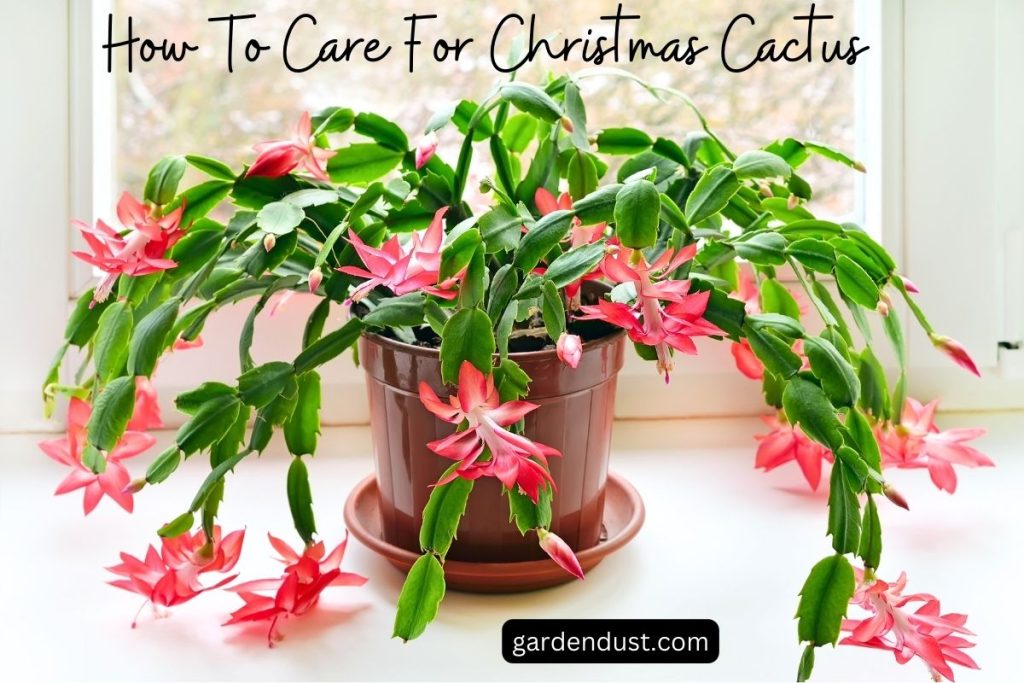The Christmas Cactus (Schlumbergera) is a captivating and festive addition to any indoor garden, known for its vibrant blooms that coincide with the holiday season. However, to ensure the longevity and health of this beautiful succulent, it requires specific care and attention. In this comprehensive guide, we will delve into the intricacies of how to care for Christmas Cactus, providing detailed insights on light, water, temperature, soil, fertilization, pruning, and common issues. Let’s start…
Botanical Name- Schlumbergera
Family- Cactaceae
Native- Coastal mountains of Brazil
Common Name- Christmas Cactus
Blooming time -During the holiday season
Flower -vibrant and festive-colored flowers
Plant Type- succulent
Care for Christmas Cactus:-
Light Requirements
One of the key factors influencing the health and blooming of a Christmas Cactus is its exposure to light. While these plants thrive in bright, indirect light, they are not fond of direct sunlight, especially during the intense midday hours. To replicate their native Brazilian forest environment, place your Christmas Cactus near a window where it can receive filtered sunlight. An east or north-facing window is ideal. If growing indoors, supplement natural light with fluorescent lights if needed, especially during the darker winter months.
Watering Techniques
Proper watering is paramount for the well-being of your Christmas Cactus. These succulents prefer consistently moist but not waterlogged soil. Allow the top inch of the soil to dry before watering, ensuring that the roots receive the moisture they require. Overwatering can lead to root rot, a common issue with Christmas Cacti. When watering, use room temperature water and ensure that excess water can drain away freely. Consider using a saucer beneath the pot to catch any runoff.
Temperature Considerations
Maintaining the right temperature is crucial for the health and blooming of your Christmas Cactus. These plants thrive in cooler temperatures during the fall and winter, with an optimal range between 60-70°F (15-21°C). However, during the spring and summer months, they can tolerate slightly higher temperatures. Avoid exposing your Christmas Cactus to sudden temperature changes, as they are sensitive to drafts and extremes.
Soil Selection
Choosing the right soil mix is essential for the well-being of your Christmas Cactus. Opt for a well-draining, slightly acidic mix that replicates its natural habitat. A mix of potting soil, perlite, and sand can provide the ideal balance. Ensure that the pot has drainage holes to prevent water from stagnating at the bottom, reducing the risk of root rot.
READ ALSO:-How to Grow and Care for Succulents
Fertilization Routine
To encourage healthy growth and prolific blooming, Christmas Cacti benefit from regular fertilization. During the growing season, typically from late spring to early fall, feed your plant with a balanced, water-soluble fertilizer every 2-4 weeks. Reduce or eliminate fertilization during the fall and winter when the plant is entering a dormancy period. Always follow the recommended dosage on the fertilizer package to avoid over-fertilizing, which can be harmful to the plant.
Pruning for Shape and Blooms
Pruning is a valuable practice for maintaining the shape and encouraging abundant blooms on your Christmas Cactus. After the blooming period, usually in late winter or early spring, you can prune the plant by pinching or cutting back the stems. This not only helps in shaping the plant but also stimulates the growth of new segments that will produce flowers in the next blooming season. Remove any dead or yellowing segments to promote overall plant health.
Addressing Common Issues
Despite your best efforts, your Christmas Cactus may encounter a few common issues. Here’s how to troubleshoot them:
- Root Rot: If you notice wilting or blackening of stems, it might be a sign of root rot. Check the roots and trim away any rotting parts. Repot the plant in fresh, well-draining soil.
- Yellowing Leaves: Overwatering or underwatering can lead to yellowing leaves. Adjust your watering routine, ensuring the soil is consistently moist but not waterlogged.
- Lack of Blooms: A failure to bloom can be attributed to insufficient light, high temperatures, or improper dormancy conditions. Ensure your Christmas Cactus is exposed to bright, indirect light and experiences a cool period of about 12-14 hours of darkness per day for at least four weeks in late fall to stimulate blooming.
- Pests: Keep an eye out for common pests like spider mites and aphids. If detected, treat them promptly with insecticidal soap or neem oil.
Propagation Techniques
If you wish to share the joy of your Christmas Cactus with friends and family, propagation is a simple and rewarding process. Propagation can be achieved through:
- Segment Cuttings: Gently remove a healthy segment of the plant, ideally with three to five leaf segments. Allow the cut end to callous for a day or two before placing it in a well-draining potting mix. Keep the soil consistently moist until roots develop.
- Offsets: Christmas Cacti naturally produce offsets or side shoots. Detach these offsets and plant them in their individual pots, following the same care guidelines as for mature plants.
Caring for a Christmas Cactus is a delightful journey that rewards you with vibrant blooms and a touch of festive cheer. By providing the right balance of light, water, temperature, soil, and nutrients, and by incorporating proper pruning and troubleshooting techniques, you can ensure that your Christmas Cactus remains a healthy and flourishing part of your indoor garden. Remember, each plant is unique, so pay attention to its individual needs, and you’ll enjoy the beauty of this captivating succulent for years to come. Happy Gardening…







